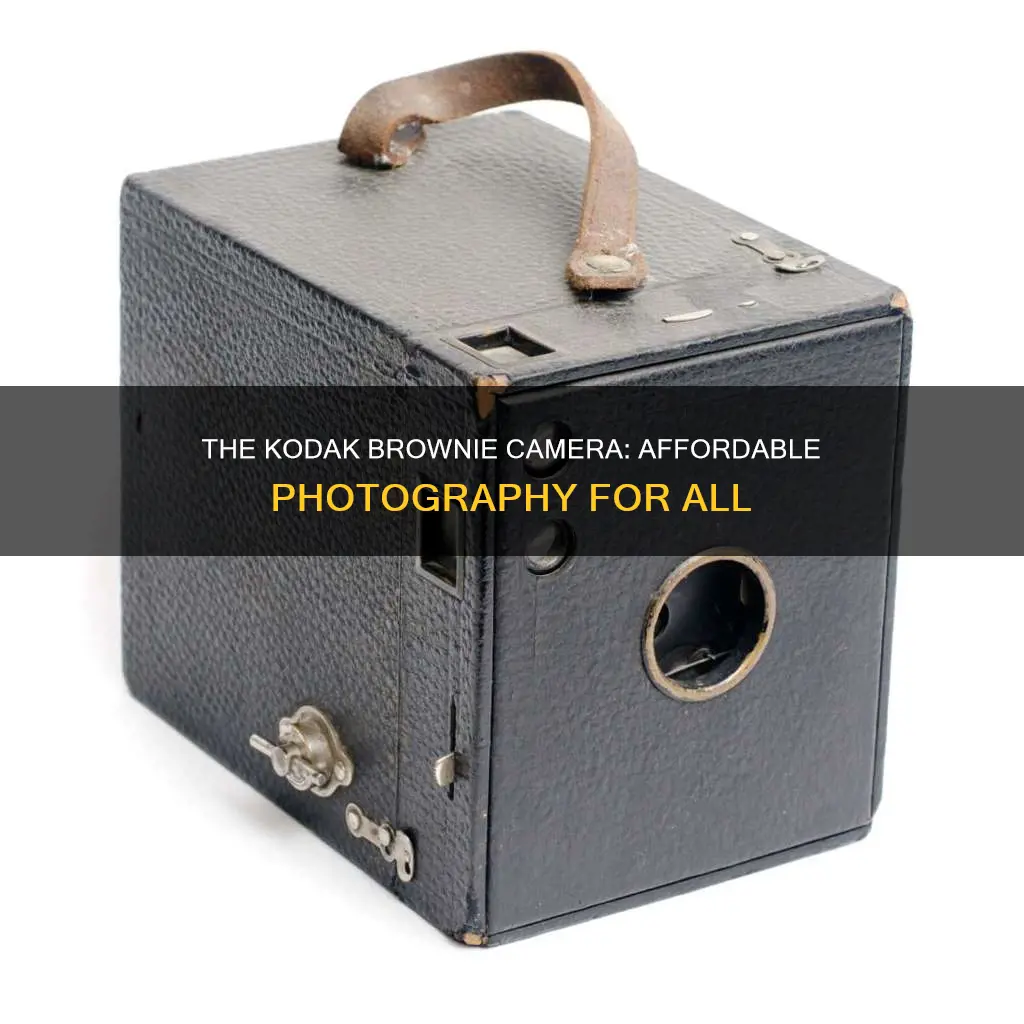
The Kodak Brownie was a series of camera models first released in 1900. It was a simple cardboard box camera with a basic lens that took 2+1⁄4-inch square pictures. The Brownie was affordable, handy, and easy to use, and it played a significant role in popularising photography among the masses. Its low cost, simple controls, and marketing targeted at children and amateurs made it widely accessible, and it sold over 150,000 units in its first year of production. The camera's success continued for decades, with Kodak releasing various models and updates, capturing raw and candid moments of the 20th-century experience.

Affordable price
The Kodak Brownie camera was popularised by its affordable price, which made photography accessible to the masses.
The first Kodak Brownie camera was released in 1900 for an initial price of just $1, which is equivalent to about $33 in today's money. This made it the first camera that was affordable to people who weren't wealthy hobbyists. The low price point meant that over 150,000 Brownie cameras were shipped in the first year of production.
The Brownie was a basic cardboard box camera with a simple convex-concave lens. Its film could be taken out of the camera after shooting and developed at home. The camera's controls were simple, and the price of Kodak roll film and processing was low. This meant that, for less than $2, anyone could buy a Brownie camera, a roll of film, and get it processed.
The No. 2 Brownie, released in 1901, was also a huge success. It produced larger photos and cost just $2.
The Brownie's affordability, along with its simple design and operation, helped it achieve broader appeal beyond its initial target market of children.
Leatherette Camera: What's It Really Made Of?
You may want to see also

Simple to use
The Kodak Brownie was simple to use. Its basic cardboard box design, with a simple convex-concave lens, was easy to operate. The Brownie was aimed at children, with an advertising campaign targeted at kids, and so it was designed to be used right out of the box. It was also cheap, costing just $1, and the film was inexpensive too, so anyone could take pictures casually. The Brownie's simple controls meant that anyone could operate it, and it didn't require any special knowledge.
The Brownie was a basic camera, with a simple design and operation, but it could produce very good results under the right conditions. Its simple meniscus lens, with a fixed-focus, was capable of capturing reasonably sharp, clear pictures. The Brownie's lens apertures were pre-determined at the factory, and its rotary shutter was single-speed or single-speed with a bulb setting. The Brownie's viewfinders had a reflex mirror assembly, with a window in the front and top of the camera, and an angled mirror inside that connected the two. This allowed the photographer to compose the picture by holding the camera at waist level and looking down into the finder.
The Brownie's simplicity was its greatest feature, and it was this that made it so popular. It was a camera that anyone could use, and it brought photography to the masses. The Brownie was a runaway hit, with 245,000 units of the original model sold, and it spawned many different variations over the years. The Brownie series turned photography into an everyday activity and captured raw, candid accounts of the 20th-century experience.
Live Mode: iOS Camera's Hidden Feature
You may want to see also

Effective marketing
The Kodak Brownie was a series of camera models first released in 1900. It was the first camera to be produced cheaply and marketed to non-professionals, making photography accessible to the masses. The Brownie was sold at an initial price of $1 (equivalent to $37 in 2023), and its simple controls meant that anyone could operate it straight out of the box. Kodak also offered affordable film and processing, with a roll of film costing less than $2. The camera's affordability and ease of use were key to its success, with over 150,000 Brownie cameras sold in the first year of production.
The marketing genius of George Eastman, founder of the Eastman Kodak Company, played a significant role in the popularity of the Kodak Brownie. Eastman recognised the potential profits in a mass-market model and targeted his advertising at children and young people. He chose the name "Brownie" for the camera, inspired by the popular series of children's books by Canadian artist and writer Palmer Cox, which featured magical "Brownie" characters. These characters became the mascots for the cameras, and Eastman Kodak saturated magazines and newspaper ads with images of them, addressing children users as "Brownie boys and girls." The company even launched the Brownie Camera Club of America and periodical books that included fictional stories about the fairy origins of the camera. This clever marketing strategy created a sense of community and appealed to the target audience, contributing to the widespread adoption of the Kodak Brownie.
The Kodak Brownie's marketing campaign was so successful that it changed the relationship between the average person and photo images. By introducing affordable and easy-to-use cameras to the market, Kodak democratised photography and made it an everyday activity. The Brownie's simplicity and portability kept it in production until 1986, with countless new models and updates released over the years. The camera's ability to capture candid and authentic moments became an important facet of the 20th century, and its snapshots continue to hold magic and appeal today.
Best Cameras Compatible with the AZ16-1 Battery
You may want to see also

Accessible film
The Kodak Brownie was a series of camera models first released in 1900. The Brownie was a basic cardboard box camera with a simple convex-concave lens that took 2+1⁄4-inch square pictures on No. 117 roll film. It was conceived and marketed to sell Kodak roll films.
The Brownie was designed to be accessible to the masses. Its simple controls and initial price of US$1 (equivalent to $37 in 2023) made it affordable to most people. The low price of Kodak roll film and processing further enhanced its accessibility. For less than $2.00, anyone could buy a Brownie, a roll of film, and get it processed.
The camera's simplicity also made it easy to use. It had a detachable film winding key, a rotary shutter, and V sighting lines on top (a clip-on accessory reflecting finder was available separately). Each exposure was made by pressing a lever on the side of the camera, and the frames were advanced between shots using the winding knobs on the side of the box.
The original Brownie was produced in 1888 and released in February 1900. Over the next 70 years, Kodak built upon its success with countless new models and updates. The company released the Brownie in various materials, including cardboard, aluminium, and colour models, and introduced new features such as built-in flash and folding designs.
The Brownie's accessibility and ease of use played a significant role in its popularity, making photography an affordable and everyday activity for people from all walks of life.
Recharging Camera Batteries: A Quick Guide to Powering Up
You may want to see also

Social impact
The Kodak Brownie camera had a significant social impact, challenging societal norms and creating new legal precedents. Here are some key aspects of its social impact:
Democratisation of Photography:
The Brownie camera played a pivotal role in democratising photography and making it accessible to the masses. Before the Brownie, photography was mostly a professional pursuit or the hobby of wealthy enthusiasts due to the cost and complexity of equipment. The Brownie, with its low price point of just $1 (equivalent to $32-37 in 2023 dollars), simple design, and easy-to-use roll film, opened up photography to average families. It introduced the concept of "snapshots", allowing anyone to capture quick and casual moments in time.
Impact on Social Norms:
The widespread adoption of the Brownie camera had a profound impact on social norms and expectations of privacy. As the camera became ubiquitous, people from all walks of life, including children, started taking photographs. This led to a shift in societal norms around privacy, as everyday citizens could now capture and share images of intimate, embarrassing, or vulnerable moments that were previously unthinkable. The public's sense of propriety began to relax to accommodate this new fascination with photography.
Legal Precedents and Privacy Rights:
The Brownie camera played a significant role in shaping privacy rights and legal precedents. The increased accessibility of photography brought with it a heightened risk of privacy invasion. One notable example is the case of Abigail Robertson, a teenager from Rochester, New York, who sued a company for using her photograph without consent in advertising posters. While she initially lost the case, the incident sparked a broader conversation about privacy rights, leading to New York becoming the first state to recognise an individual's right to control the use of their name and image for advertisement and trade. The Brownie camera also influenced the Harvard Law Review's influential article, "The Right to Privacy" by Samuel D. Warren and Louis Brandeis, which became a landmark in American legal history.
Capturing Historical Moments:
The simplicity and portability of the Brownie camera meant that it was used to capture many iconic and historical moments of the 20th century. For example, Bernice Palmer used a Brownie camera to photograph the iceberg that sank the RMS Titanic in 1912, as well as survivors aboard the RMS Carpathia. Soldiers also took Brownie cameras to war, documenting the harsh realities of World War I. The Romanov family, including the four OTMA sisters, also used Brownie cameras to capture panoramic photos during their exile in Crimea.
Empowering Amateur Photographers:
The Brownie camera challenged the notion that expensive equipment was necessary for quality photography. Amateur photographers, such as Bert Hardy, achieved iconic shots with the Brownie, demonstrating that great photographs could be captured without sophisticated gear. This empowered everyday people to embrace photography as a hobby and document their lives and surroundings.
Roku and Wyze: What's the Camera Connection?
You may want to see also
Frequently asked questions
The Kodak Brownie camera was initially priced at $1 (approximately $37 in 2023).
The Kodak Brownie was a simple cardboard box camera with a basic convex-concave lens. Its simple controls and low price made photography accessible to the masses.
More than 150,000 Kodak Brownie cameras were sold in the first year of production.
The Kodak Brownie camera was initially marketed to children, with Kodak using the popular "Brownie" characters from Canadian writer Palmer Cox to popularise the camera. However, it achieved broader appeal as people realised that the camera, despite its simple design, could produce good results under the right conditions.







